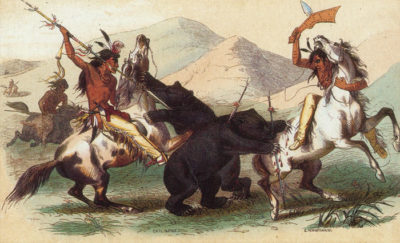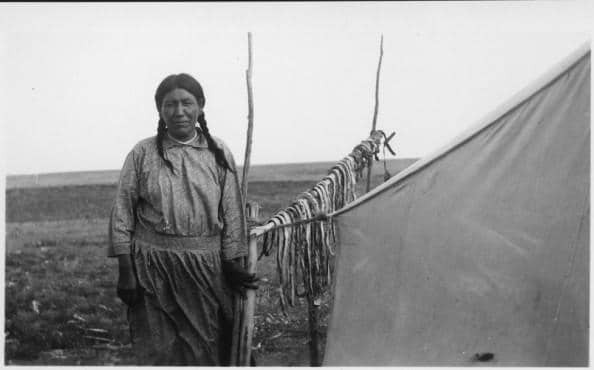Traditional food preservation and storage methods have seen an uptick in popularity in the past decade, as people show an interest in learning how the native people of America preserved food and kept it safe for later consumption without refrigeration.
Of course, in winter months, storing food to prevent spoilage wasn’t such a huge concern, but in some parts of the country, indigenous people lived in areas that did not freeze or had a small number of freezing incidents.
Let’s take a look at how the native people dried and stored fruits, vegetables, and meat for consumption during the winter months or for times when food was scarce.
The 5 Types of Food Typically Preserved
- Foods above ground: berries, fruit, nuts, corn, squash
- Foods below ground: roots, onions, wild potatoes
- Fish
- Birds
- Animals with 4 legs: buffalo, deer, elk
One of the factors that was critical to nomadic tribes, such as the Lakota, was that food needed to be portable. Nomadic tribes generally moved every few weeks (or months, depending on the size of the tribe) so that they did not strip the area of food and firewood, as well as to keep their horses fed. This means that food needed to be dried and made into the smallest, lightest form possible.
For example, while Southwestern tribes, such as the Hopi, could afford to simply dry corn on the cob and store the entire cob in sealed-off rooms, other tribes would strip the corn kernels off for storage. Keep in mind that the corn native people used was not the same corn we see in our supermarkets today.
The Quickest And Easiest Way To Store A Month’s Worth Of Emergency Food!
Corn was typically dried on the cob, laid out on flat rocks, grass mats or hides. Children and the elderly would typically be in charge of drying food, turning it regularly and removing flies, ants or scaring away birds and raccoons.
Other types of fruit were picked and dried in the same manner. While each tribe had their own way of dealing with vegetables, the methods were the same: to dry out the vegetable so that it could be preserved for later consumption. Many tribes would cut the vegetable, such as squash, into strips, flatten it out using a bone or rock, and then dry these thinned-out pieces in the sun.
Preserving Meat and Fish
Although the native people had no scientific evidence to fall back on, they learned over thousands of years that some foods would not store well and would go rancid quickly unless cooked, dried or somehow preserved.
Fish was often smoked to preserve it for later consumption. Once gutted, the entire fish was often placed over a low fire that included a great many green branches, so that the heat and smoke would dry out the fish meat. Salmon, due to their size, were often cut into strips, and then smoked and dried.
 Most other types of meat were cut into long strips and the fat removed. The fat was placed in cooking “pots.” If it was the beginning of the hot, dry season, meat would then be placed on rocks or racks made from tree branches so that it would dry in the sunlight. Again, children and the elderly did their share of work by fanning away flies, insects and marauding animals such as dogs or raccoons. If time was short, the meat was sometimes dried and/or smoked under a very low fire. This dried meat is typically referred to as “jerky.” It could be made soft again by cooking it in a soup and was often served along with other vegetables.
Most other types of meat were cut into long strips and the fat removed. The fat was placed in cooking “pots.” If it was the beginning of the hot, dry season, meat would then be placed on rocks or racks made from tree branches so that it would dry in the sunlight. Again, children and the elderly did their share of work by fanning away flies, insects and marauding animals such as dogs or raccoons. If time was short, the meat was sometimes dried and/or smoked under a very low fire. This dried meat is typically referred to as “jerky.” It could be made soft again by cooking it in a soup and was often served along with other vegetables.
The fat from large animals, such as buffalo or elk, was collected and then put through a process called rendering. Animal fat is very dense in calories, but it goes rancid quickly. Indigenous people learned to render fat by cooking it, along with small amounts of water, under a low heat. All pieces of meat or other tissue will come to the surface and are removed. Rendered fat will last about one year without refrigeration if kept out of direct sunlight.
Pemmican: The Fast Food of Native Tribes
Pemmican was made by many tribes of the north and northeast, including the Cree, Chippewa and Lakota. While the “recipe” varied, the basic pemmican is dried, pulverized meat and dried berries, held together by rendered fat. This mixture was often made into golf-ball sized pieces. The meat could be whatever was handy or what was plentiful at the time, including moose, elk or bison. The fruit used was often dried chokecherries, blueberries or cranberries. Dried meat would be pulverized into almost a powder, the dried fruit also broken down into smaller pieces, and then mixed with the rendered fat. These balls of pemmican were then placed in rawhide bags for storage and transportation.
Pemmican is a nutrient- and calorie-dense food that would last for at least one year. Most tribes, as well as hunting parties, relied on pemmican to get them through the lean winter months. Most Canadian fur traders used pemmican, as well. If a person were traveling, a piece of pemmican was bitten off and then slowly chewed to soften it. If you have ever eaten jerky, you know it takes some time to break down the meat! However, pemmican could also be cooked. Some tribes would put a few balls of pemmican in a pot of water, along with some vegetables, while others would fry it with some onions or wild potatoes.
There were a great many other foods that were dried for later use or used as seasoning, including sage, dandelions, wild rice (which is actually a grass, but grows in wetlands much like rice), pumpkins, beans, azafran, sunflower seeds, acorns, mustard seeds, cactus, tomatoes and plantain (the greens, not the bananas!). What was collected and dried varied a great deal, depending on the climate and what was in season.
While most of us rely on our dehydrators or ovens for drying meat or fruit, the native people of America did it all by hand, relying only on their skill and the power of the sun or fire.
What advice would add on preserving food without refrigeration? Share it in the section below:
Discover The Secret To Saving Thousands At The Grocery Store. Read More Here.
 Off The Grid News Better Ideas For Off The Grid Living
Off The Grid News Better Ideas For Off The Grid Living




